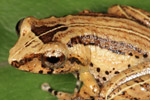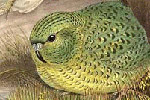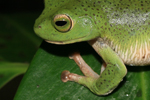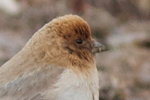Scientific American magazine recently ran an article on the rediscovery of the smoothtooth blacktip shark (Carcharhinus leiodon) in a Kuwaiti fish market. Believed extinct for over 100 years, the smoothtooth had not been seen since the naturalist Wilhelm Hein returned from a trip to Yemen in 1902. With its reappearance, scientists scoured Kuwaiti markets and discovered an astounding 47 individual smoothtooth blacktips.
Studying the dead sharks has helped scientists make various discoveries about this virtually unknown species’ natural history, such as how many pups they bear and how they use their habitat. This information has helped scientists put together a conservation action plan for the smoothtooth blacktip shark.

Another species of blacktip shark (Carcharhinus limbatus). Photo in the public domain.
Amazingly, this isn’t the first time a long lost species has reappeared in a food market. Here are some other astonishing examples:
Worcester’s Buttonquail
In 2008, a film crew gathering footage for a documentary on bird trapping in the Philippines took some photos and video of a small nondescript bird before it was sold at a poultry market to be eaten. When an ornithologist from the Wild Bird Club of the Philippines saw the film, he was aghast: it was the Worcester’s buttonquail (Turnix worcesteri), a species believed extinct. Belonging to the famously cryptic Turnicidae family, Worcester’s buttonquail may continue to survive undetected, or it may not.
Laotian Flying Squirrel
 The true colors of the Coelacanth, brought to life at the Oxford University Museum of Natural History. Photo under the GNU Free Documentation License. |
In addition to yielding rediscovered species, markets sometimes reveal totally undiscovered animals. A master’s student from a 2012 team from the National University of Laos found the first ever Laotian flying squirrel (Biswamoyopterus laoensis) while on a trip specifically to look through meat markets for animals of interest to science. The Laotian flying squirrel is only the second member of its genus (Biswamoyopterus), and has never been seen alive.
Arakan Forest Turtle
Only found on the Arakan hills of western Myanmar, the 1994 rediscovery of the Arakan forest turtle (Heosemys depressa) in a Chinese food market marked the first time the creature had been seen since a British army officer collected one in 1908. The tiny turtle has since been observed by scientists in the wild.
Coelacanth
When a species goes undetected for a hundred years before reappearing, we’re left in awe; but consider the story of the coelacanth, which was presumed extinct for 65 million years. Known to scientists from fossils, the coelacanth (Latimeria chalumnae) was first made known to science in the flesh in the catch of an angler in eastern South Africa in 1938. Believed to have disappeared in the Late Cretaceous period, a second species of coelacanth (Latimeria menadoensis) was discovered in 1998.
Related articles
Not seen in over 130 years, ‘extinct’ frog rediscovered in Sri Lanka

(01/10/2014) In 1876—the same year that the first telephone call was made—the British scientist Albert Günther described a new species of frog from Sri Lanka, but the species, known as the webless shrub frog (Pseudophilautus hypomelas), was never seen again. Having disappeared into history, scientists considered the species extinct—that is until a 2010 expedition stumbled on 40 mystery frogs.
Naturalist rediscovers the long-lost night parrot

(07/16/2013) An Australian bushman and naturalist claims to have captured video footage of the night parrot, a bird not seen alive for more than a century. John Young, who describes himself as a wildlife detective, showed the footage and a number of still photos of the bird to a packed room of enthusiasts and media at the Queensland Museum on Wednesday. The desert-dwelling night parrot, Pezoporus occidentalis, has never been photographed and the only evidence of its continued existence has been two dead birds found in 1990 and 2006.
Starry frog rediscovered after thought extinct for 160 years (photos)

(03/07/2013) In 1853 Edward Frederick Kelaart, a physician and naturalist, collected a strange frog on the island of Sri Lanka then a British colony known as Ceylon. The specimen was a large shrub frog (about 2 inches or 5.5 centimeters long) with black-outlined white specks on lime-green skin. He dubbed it “starry” after its pale specks, but that was last anyone heard of it. Even the holotype—the body of the amphibian collected by Kelaart—went missing. Fast forward nearly 160 years—two world wars, Sri Lanka’s independence, and a man on the moon—when a recent expedition into Sri Lanka’s Peak Wilderness rediscovered a beguiling frog with pinkish specks.
Photo: high-altitude bird rediscovered after 80 years

(10/29/2012) In 1929 the U.S. Stock Market collapsed, the Geneva Convention set standards for prisoners of war, the first Academy Awards was celebrated, and Jérôme Alexander Sillem collected two bird specimens on a high plateau in Xinjiang, China. For 62 years, the specimens sat in a drawer at the Zoological Museum of Amsterdam until C. S. Roselaar found them, studied them, and determined they, in fact, represented a new species of bird: Sillem’s mountain finch (Leucosticte sillemi). Now, 83 years after Sillem collected the only known specimens, a French photographer, Yann Muzika, unwittingly took photographic proof that the finch species still survives.